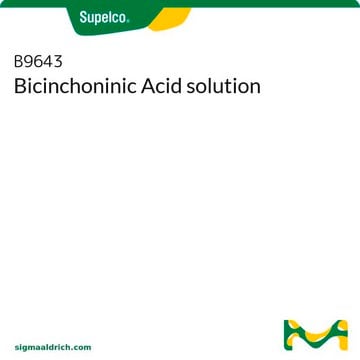Recommended Products
shipped in
wet ice
storage temp.
−20°C
Application
Reversible covalent binding to proteins by the fluorophore epicocconone provides a powerful and sensitive method for protein quantification
Features and Benefits
- Yields an intense fluorescent red on protein binding
- Binding is completely reversible making the protein suitable for mass spectrometry and functional assays
- Water soluble proteins may be quantified without using organic solvents
- A large dynamic range, large Stokes shift and highly sensitive
- Highly tolerant of substances commonly interfering with protein quantification
- Biodegradable and environmentally friendly
Other Notes
For the quantification of total protein in solution by the interaction of a unique fluorophore with the amines of polypeptides.
Legal Information
FluoroProfile is a trademark of Sigma-Aldrich Co. LLC
Kit Components Also Available Separately
Product No.
Description
SDS
- P5619Protein Standard, analytical standard, 2 mg/vial BSASDS
Signal Word
Warning
Hazard Statements
Precautionary Statements
Hazard Classifications
Eye Irrit. 2
Storage Class Code
10 - Combustible liquids
WGK
WGK 3
Flash Point(F)
Not applicable
Flash Point(C)
Not applicable
Certificates of Analysis (COA)
Search for Certificates of Analysis (COA) by entering the products Lot/Batch Number. Lot and Batch Numbers can be found on a product’s label following the words ‘Lot’ or ‘Batch’.
Already Own This Product?
Find documentation for the products that you have recently purchased in the Document Library.
Phillip J L Bell et al.
Journal of the American Chemical Society, 125(31), 9304-9305 (2003-08-02)
Epicocconone represents a new class of natural fluorescent probes based on a polyketide skeleton isolated from the fungus Epicoccum nigrum. Epicocconone is a small, cell permeable natural product with a high molar absorbtivity and a long Stokes' shift that will
Ondřej Kaplan et al.
PloS one, 11(10), e0163697-e0163697 (2016-10-08)
We describe the production of a highly-active mutant VEGF variant, α2-PI1-8-VEGF121, which contains a substrate sequence for factor XIIIa at the aminoterminus designed for incorporation into a fibrin gel. The α2-PI1-8-VEGF121 gene was synthesized, cloned into a pET-32a(+) vector and
R P Ubrihien et al.
Archives of environmental contamination and toxicology, 82(4), 520-538 (2022-04-21)
The effects of multigenerational Cu exposure on the freshwater gastropod Isidorella newcombi were investigated. Snails were exposed to a range of treatment-specific Cu concentrations in the parental to F2 generations, and a common Cu concentration in the F3 generation. In
Jiaorong Tan et al.
Journal of diabetes research, 2019, 5483946-5483946 (2019-06-22)
This study is aimed at evaluating the effects, functions, and mechanism of HNF1α on hepatic glycolipid metabolism. In this study, free fatty acid- (FFA-) induced steatosis of hepatocyte liver cell LO2 was used as an in vitro model. The methods
Helena A Schmitz et al.
Aquatic toxicology (Amsterdam, Netherlands), 160, 22-30 (2015-01-13)
Metals are accumulated by filter feeding organisms via water, ingestion of suspended sediments or food. The uptake pathway can affect metal toxicity. Saccostrea glomerata were exposed to cadmium through cadmium-spiked suspended sediments (19 and 93μg/g dry mass) and cadmium-enriched phytoplankton
Our team of scientists has experience in all areas of research including Life Science, Material Science, Chemical Synthesis, Chromatography, Analytical and many others.
Contact Technical Service









